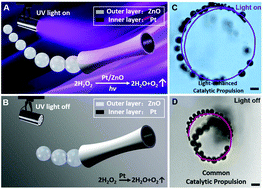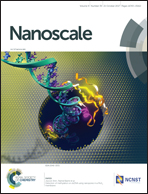ZnO-based microrockets with light-enhanced propulsion†
Abstract
Improving the propulsion of artificial micro–nanomotors represents an exciting nanotechnology challenge, especially considering their cargo delivery ability and fuel efficiency. In light of the excellent photocatalytic performance of zinc oxide (ZnO) and chemical catalytic properties of platinum (Pt), ZnO–Pt microrockets with light-enhanced propulsion have been developed by atomic layer deposition (ALD) technology. The velocity of such microrockets is dramatically doubled upon irradiation by 77 mW cm−2 ultraviolet (UV) light in 10% H2O2 and is almost 3 times higher than the classic poly(3,4-ethylenedioxythiophene)–Pt microrockets (PEDOT–Pt microrockets) even in 6% H2O2 under the same UV light. In addition, such micromotors not only retain the standard approach to improve propulsion by varying the fuel concentration, but also demonstrate a simple way to enhance the movement velocity by adjusting the UV light intensity. High reversibility and controllable “weak/strong” propulsion can be easily achieved by switching the UV irradiation on or off. Finally, light-enhanced propulsion has been investigated by electrochemical measurements which further confirm the enhanced photocatalytic properties of ZnO and Pt. The successful demonstration of ZnO-based microrockets with excellent light-enhanced propulsion is significant for developing highly efficient synthetic micro–nanomotors which have strong delivery ability and economic fuel requirements for future practical applications in the micro–nanoscale world.



 Please wait while we load your content...
Please wait while we load your content...